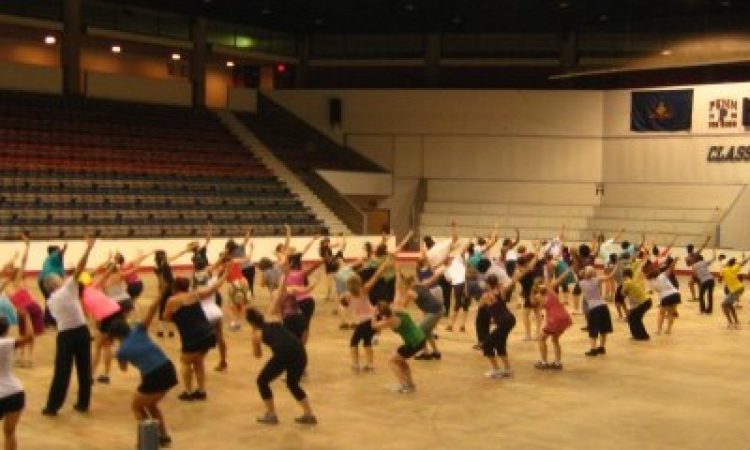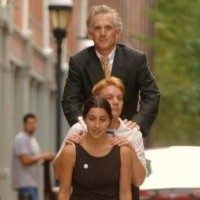The post-moderns not only asked “what is dance?” but also “who can or should the dancer be?”. The latter question will soon receive the resounding answer–“Everyone!”–from the
150 performers dancing in the forthcoming Philadelphia Live Arts Festival production of Sylvain Émard’s Le Grand Continental.
Continental is Whitmanesque in its passionate inclusiveness. It joyfully welds social dance and popular music with a witty, sophisticated contemporary dance consciousness. The work premiered in Émard’s home city of Montreal in 2009 for the Festival TransAmériques, and has developed considerably in subsequent productions in Montreal, Mexico City and, most recently, in New York City this past June. Earlier this summer, with the energy and charm of a devilish Pied Piper, the French Canadian choreographer enticed over 150 people from the Philadelphia region (including this writer), aged 8 to 69, and of all dance backgrounds (including none), to dedicate their summer evenings to learning complex choreography for the 30-minute non-stop dance.
Continental will be presented with pre-recorded music in three free performances on September 8 and 9 in front of the Philadelphia Museum of Art. Following each performance will be a dance party with the audience.
Although an egalitarian spirit has long infused social dance in many cultures, dance’s “high art” profile rendered it exclusionary until the political and art awakenings of the 60s, which allowed those often termed non-dancers (here our language fails) to join trained dancers in revitalizing both dance and life. Among the first generation of post-modern choreographers, Deborah Hay in her Ten Circle Dances for Everybody (1975)crafted instructions for folk-like dances with friends to popular music. Anna Halprin’s “rituals” created communities of dancers and non-dancers, joining audience and performers. In the mid-60s, Yvonne Rainer’s work joined professional dancers and non-professionals (albeit artists like Carl Andre and Robert Morris) to tap into deskilled and ordinary movement.
In Philadelphia, Leah Stein has for over two decades skillfully integrated performers of all dance backgrounds (including this writer) into her lyrical, site specific works which took place in Schuylkill Park, along the Manayunk Canal and at Bartram Gardens. In her more recent dance/choral works, Urban Echo: Circle Told (2008) and Battle Hymns (2009) she set movement upon the more typically stationary singers of the Mendelssohn Club Chorus. Headlong Dance Theater playfully tickled the non-dancer audience members’ multiple senses, including kinesthetic consciousness, and got them dancing in Cell (2006). In the upcoming Live Arts Festival’s This Town is a Mystery, the company is creating dances performed solely by neighborhood residents in their own living rooms. If Headlong’s latest experiment is non-professional performer inclusiveness at the micro level, then Émard’s Continental appears on the macro scale. Both share a similar utopian spirit.
Setting the bar high
Émard, as one rehearsal assistant told me, has in no way dumbed down his choreography to accommodate his diverse crew of performers, setting the bar high with complex movement which he acknowledged to me as a “big challenge for most.” All the rehearsal assistants I spoke to agreed with these observations. (The assistants, coming from different dance backgrounds, will be joining in the September 8 and 9 performances. They are Sarah Gladwin Camp, rehearsal director, Jacelyn Biondo, Bethany Formica, Duane Holland, Megan Mazarick, Rhonda Moore, Gabrielle Revlock, Les Rivera, and Kristen Shahverdian.)
Émard’s prior and distinguished avant garde creations first bore the imprint of his work and interest in the theater,. He then pursued more formal and abstract concerns. His dances are “always very physically elaborate, quite challenging, and seeking to enhance the fragility of human nature on stage,” he says. ( see http://www.sylvainemard.com/en/ ). Three of his repertory pieces and a newly commissioned “self-portrait” solo will be presented at the Biennale de Danse in Bordeaux next spring. I hope that a Philadelphia presenter soon considers his other work for audiences here in the future.
In Continental, Émard uses line dancing, the first dance he experienced as a nine year old in the basement of a Montreal parish hall in the 60s. He explained that his family shared the common bias that classical dance was not for boys, leading him into gymnastics, acrobatics, corporeal mime and theater instead. Émard believes that most professional dancers like himself “were mostly attracted to dance via social dances,” and that Le Grand Continental “is a homage to a form of dance that brought us here.” But rather than simply recycling social dance, Émard in his own unique hybridization, traverses “the borderline between social dance and contemporary dance.” He explains, for example, that he “twists popular steps to make them look different.”
Taking shape in Philadelphia
He is setting 150 dancers on a grid in two groupings that are at times in total unison and other times subtly mirroring each other in unison movement. He injects quick paced and constant changes in direction so that there is no “front” to the work. Instead it is framed by the Art Museum on side and the Ben Franklin Parkway opposite. The dance moves in and out of syncopation, unexpectedly breaking up eight counts. Émard creates patterns as quickly as he breaks them apart and constantly injects dynamic changes for the arms and torsos. He has confidence that his performers will “know what they are doing so that the audience will be able to read the movement and its intention, with their unison movement creating a big common energy.” He is comfortable with differences amongst performers, and says, “I don’t want it to be an anonymous piece. It should be clear enough to read but also see it through individuals interpreting it. I want the audience to see the ensemble and also see the individual.”
Émard’s combination of inclusiveness and demanding choreography has led to nearly 20 two-hour rehearsals throughout the summer with a large number of performers coming an hour early for additional rehearsal, as well as “optional” weekly clinic sessions, that took place on concrete, dusty floors during many sweltering nights. And for homework, Émard and his Philadelphia rehearsal assistants created three separate videos for each section of the work (one instructional, one to the counts, and a third at full speed to the music).
( http://vimeo.com/groups/149156).
The music mix
The recorded music reflects the high energy and humor of the piece. The section titled India has the big band jazz sounds one might hear in Hollywood movies of the 30s ( Stormy Weather’s “Diga Diga Doo,” or London Melody’s “Jingle of the Jungle”). In rehearsal, Emard called some phrases “elephant” and “jungle” to complete this picture. The Champagne section uses techno music; the IMA section injects ethereal, from-another-world vocals; and Cumbia has Latin rhythms composed locally for the previous Mexico City performance (apparently rendering Mexicans especially proud of this section in subsequent performances outside Mexico).
The choreographer also commissioned Philadelphia musician/composer, Michael Kiley, to write a new R&B section using the “Sound of Philadelphia” instrumental music of the late 60s and early 70s of the Gamble & Huff studio here. Kiley mixed a total of 20 songs of that era into this new Philly Soul section. Be prepared in the performance of Philly Soul for a warm audience response to Émard’s dances and the Kiley mix which includes “Love Train,” the Soul Train theme of “TSOP,” and “If You Don’t Know Me By Now.”
A dancing community
Émard has not only created a dynamic public performance but has also fashioned, through performance, a community of professional and non-professional dancers. Bethany Formica, a 20-year veteran professional dancer, speaks of the “sheer love and joy of dancing with others, of getting back to the roots of why I got into dance.” She adds that “contemporary dancers are often isolated and appear before smaller audiences, which isn’t enough anymore,” and that “it’s very nice to be dancing as part of a more general population.” She cites the experience as “empowering for the professional dancers,” and has inspired her to pursue dance in the general community. Émard especially values what he describes as the “cultural encounter” with local dance and music artists he works with to present the piece.
The heightened excitement and dedication of the non-professional dancers is a constant in rehearsals, as their varied backgrounds create a delectably unique mix. Patty Bulack, an American-born Chinese, West Philadelphia mother who home-schools her children, had to persuade her three dance-focused sons, Ian, 11, David, 14, and Jonathan, 27 (the latter a professional hip-hop dancer with Clyde Evans) that Continental was a serious, modern dance undertaking. She thought this might be the only time that mom, with no dance background, could dance together with her sons.
For many with no dance training or experience, like Selome Haile, a software engineer who came to the US from Ethiopia in 2000, and Ana Radonjic, a Yugoslavian post-doc fellow in the Psychology Dept. at Penn, the experience is about discovering what it means to be a performer and learn choreography (and get lots of exercise). Jim Lemma has been a figure roller skating teacher and performer for over 30 years, doing free style R&B and House music dance in his leisure time. He, like many others I interviewed, are excited about jumping into dance classes after the Continental performance– Jim’s choice will be hip-hop. Nicole Herndon, who has danced hip-hop socially and pursued Zumba (a common experience for many), brought her nine year-old niece, Alexis, whose dance experience to date has been in small school groups and seeing Michael Jackson via Xbox or Zumba via the Wii electronic game.
When asked how the Philadelphia performers compared to those in the almost half-dozen prior productions, Émard told me that Philadelphia was the most diverse group of dancers that has ever performed Continental in terms of race and ethnicity, background, employment and “with the most kids–lots of kids.” Look for their special role in the piece.
If you don’t catch something of the “people all over the world, join hands” refrain from the O’Jay’s Love Train in the Philly Soul section, you certainly will be seeing them in front of the Art Museum on that weekend after Labor Day. And as the O’Jay’s added, “you don’t need no tickets.”
Le Grand Continental, Sylvain Émard Danse, Philadelphia Art Museum steps, 26th Street and the Benjamin Franklin Parkway, Sept. 8, 4 and 8 p.m., Sept. 9, 4 p.m., www.livearts-fringe.org






